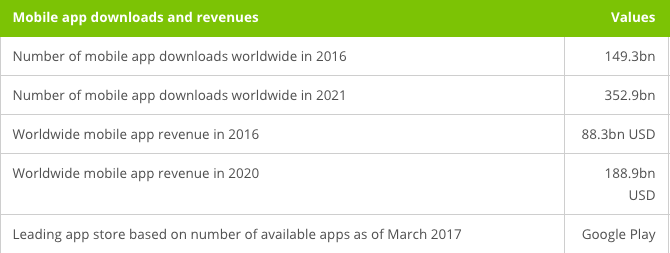
We’re well into the age of mobile, and there’s no going back. According to comScore’s 2016 Mobile App Report, mobile is now responsible for more than 65% of all digital media time, and growing. Sure that sounds like a lot, but what does it mean for mobile app developers like yourself? It means there is a lot of opportunity out there, if you can solve a real problem.
Due to the rapid speed at which mobile use is growing, companies are pushing out new mobile apps for their customers, seeking ways to earn revenue and spur engagement on mobile devices. For a sense of scale, the mobile app industry is growing so quickly that apps are expected to generate a whopping $189 billion in revenue through app stores sales and in-app advertising by 2020. (Just for fun, if it were a country, this would put the 2020 mobile app industry at around #50 when ranked by GDP, just ahead of Romania and not far behind New Zealand.)

As new technologies develop and user expectations evolve, so does the functionality of mobile apps , making it crucial for developers of all stripes to keep up with these trends to build apps that perform well and have wide appeal.
Here is our list of the critical development trends that are changing the mobile app world in 2017.
Artificial Intelligence

Forrester predicted a more than 300% increase in investment in artificial intelligence this year, and it appears they were spot on. Huge companies like Facebook, Google, and Apple are rapidly acquiring startups who are working on AI, and focusing more of their attention on using that intelligence to supercharge their mobiles apps like Siri, Google Now, and Messenger. As machine learning algorithms become more efficient, mobile developers can also expect to see these algorithms start to run directly on mobile devices instead of in the cloud. Another crucial development for mobile developers is the newly accessible abilities to run quick facial detection or process natural language from a smartphone. If you want to dabble in this area right away, mobile developers can take advantage of cloud-based AI by integrating with public APIs like API.ai or IBM Watson.
Open APIs
In the days before mobile, web browsers were the most effective means of interacting with a platform. This tight coupling between web application and web backend often led to the obfuscation and isolation of the backing API. With the advent of mobile applications, backends have adopted stricter standards and interfaces in order to accommodate a growing variety of client types. As a result, the OpenAPI specification (Swagger) was created as a means to document REST APIs in a standard, consumable format for humans and machines alike. Now, developers can interact with a rapidly growing number of 3rd party APIs and be confident in the future of API compatibility.
Accelerated Mobile Pages (AMP)
Google started the Accelerated Mobile Pages (AMP) project about a year ago and is intended to help publishers create really fast loading mobile pages. At their core AMP mobile sites are a bare bones form of HTML pages, which helps them load lightning fast.
Google AMP-supported web pages will load much faster on mobile devices and greatly reduce bounce rates. In fact, 80 percent of publishers are realizing higher viewability rates as a result. While AMP isn’t particularly useful for mobile app needs, it is certainly worth investigating more if you are focused on publishing responsive mobile web content.
Growth of the Citizen Developer
There is a major shift happening in the business world toward enabling teams outside of IT to have a stake in building apps, especially inside organizations aiming to improve their mobile presence. A 2014 IBM study found that 8 in 10 enterprises were already turning to citizen developers to increase the pace of innovation, and there are no signs this trend is slowing down this year. Dion Hinchcliffe of ZDNet writes the growth of the citizen developer is mainly driven by the fact that more organizations want to “build new home grown applications that meet today’s rich requirements and high expectations” but they lack the developer resources to do so at the speeds required.
Enterprise organizations need to innovate faster to compete, but they sometimes have long standing and slow-moving development processes, especially for mobile app projects. As a result, we’re seeing more enterprises tasking business teams, product managers, and other non IT employees with building prototypes or internal use apps using no-code and low-code solutions in an effort to pick up the pace of innovation.
Augmented Reality and Virtual Reality

Augmented Reality (AR) and Virtual Reality (VR) have been gaining momentum over the last few years with mobile games like Pokemon Go, Sky Siege, myNav, and with continuing improvements to VR devices like Oculus Rift and Samsung Gear VR.
The market for AR and VR software is expected to show huge growth by the time 2017 is over, so finding ways to integrate these technologies should be on the radar of all mobile app developers. To make it easier to get started, there are already platforms and tools out there offering AR developer kits for mobile apps- one easy and free framework for Android is DroidAR.
ReactNative
Facebook-backed JavaScript framework ReactNative is a very hot topic in mobile development communities today, and you can expect developers to continue to experiment with ReactNative this year. It uses the same design as React so you can compose a rich mobile UI on the same building blocks as regular iOS and Android apps. Hybrid apps are a great option for specific mobile use cases — but they won’t replace the growing need for high performance native apps and the advanced functionality they offer (location, push notifications, etc.) anytime soon.
The Evolution of Swift

Apple continues to evolve their programming language, Swift, as open-source software. In just a year and a half, Apple has updated Swift many times, already moving from Swift 2.0 to the current version 3.1. Each change yields improvements but does cause developers headaches, as apps must be updated to meet the changing landscape. Additionally, Xcode and other IDEs require updates each time Swift changes. It’s great to see Swift become a mature language that powers software used by hundreds of millions of people. Keep an eye on announcements from Swift to stay ahead of the curve, and know that we’re always updating the code engine behind Dropsource so that our member’s iOS apps always are up to date.
Wearables
The market for wearables is expected to see a composite annual growth rate of 20.3% before 2020. Devices like Apple Watch, Samsung Gear, Pebble 2, and others are proving that wearables are going to be among the most promising mobile app development trends for a while. As such, building apps specifically for Apple Watch or Android Watches is no longer an “out there” idea for developers. Furthermore, if you’ve got a mobile app already, do some user research and find out whether there is an innovative way to take advantage of the wearable trend and extend your application’s functionality through a wearable. Your users will thank you!
Rapid Prototyping
Rapid prototyping in this case refers to building software (web or mobile) using simple design tools or low/no code development platforms to allow for more agile user testing. Agile prototyping ultimately allows app builders to move forward quickly and with confidence, bringing their apps to the market faster and in a more informed way. There are a good deal of tools out there aimed at helping people rapidly prototype, and each have different use cases. We’ll give you a few examples.
- For the very early stages, wireframing tool Balsamiq is low-fidelity but very fast and simple to use.
- When you need higher fidelity but still static mockups, one good option is Marvel.
- For real working app prototypes, Dropsource lets you visually design your app using drag and drop and outputs a real native app.
Easy-to-Use Mobile Backends as Service (mBaaS)
Mobile apps often require a backend to provide data and user functionality. While we’re happy to see developers turning to visual development platforms like Dropsource for frontend development, as a “Bring Your Own Backend” (BYOB) platform, we know it’s equally important for developers to have easy to build and deploy backend solutions as well.
Some of platforms making major progress this year include AWS Lambda, which allows you to write small blocks of code in JavaScript and deploy them to the cloud in minutes. Alternatively, platforms such as Firebase (made by Google) or Bubble remove the need to code altogether by providing pre-packaged, scalable backend functionality.
And that concludes our list of top Mobile Trends Worth Watching in 2017!
We sincerely hope you found this post helpful and informative. We’ll keep our ears to the ground and be on the look out for the next big thing in mobile app development so we can tell you all about it!
Think we missed something or want to comment on our list?
Just post a comment below! We’d love to hear from you.



About The Author: Will Bernholz
Will is VP of Marketing at Dropsource. He is a digital marketing and communications executive with 10+ years experience driving growth and revenue. If he's not working, he's probably reading sci-fi or complaining about the current state of hip hop.
More posts by Will Bernholz